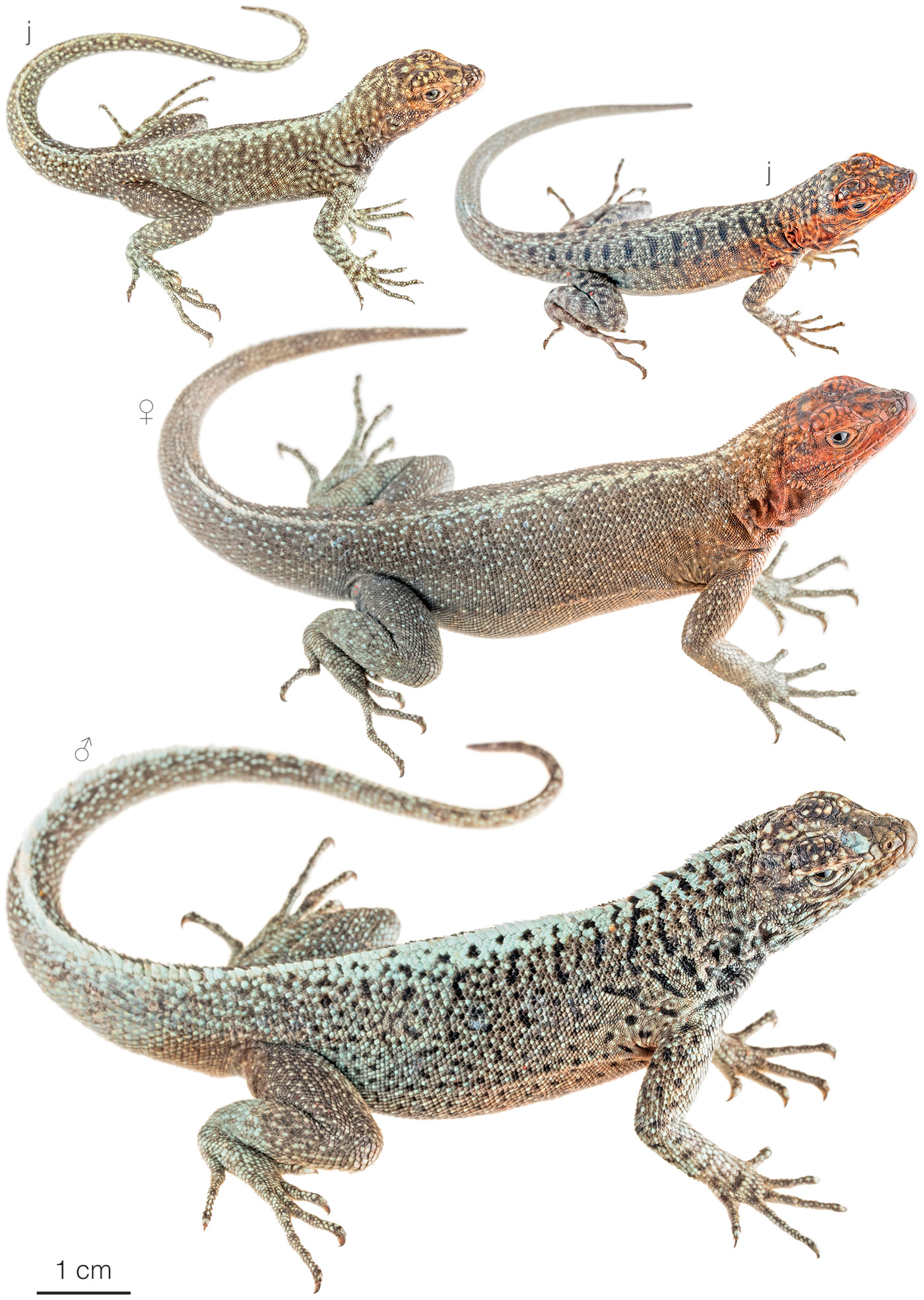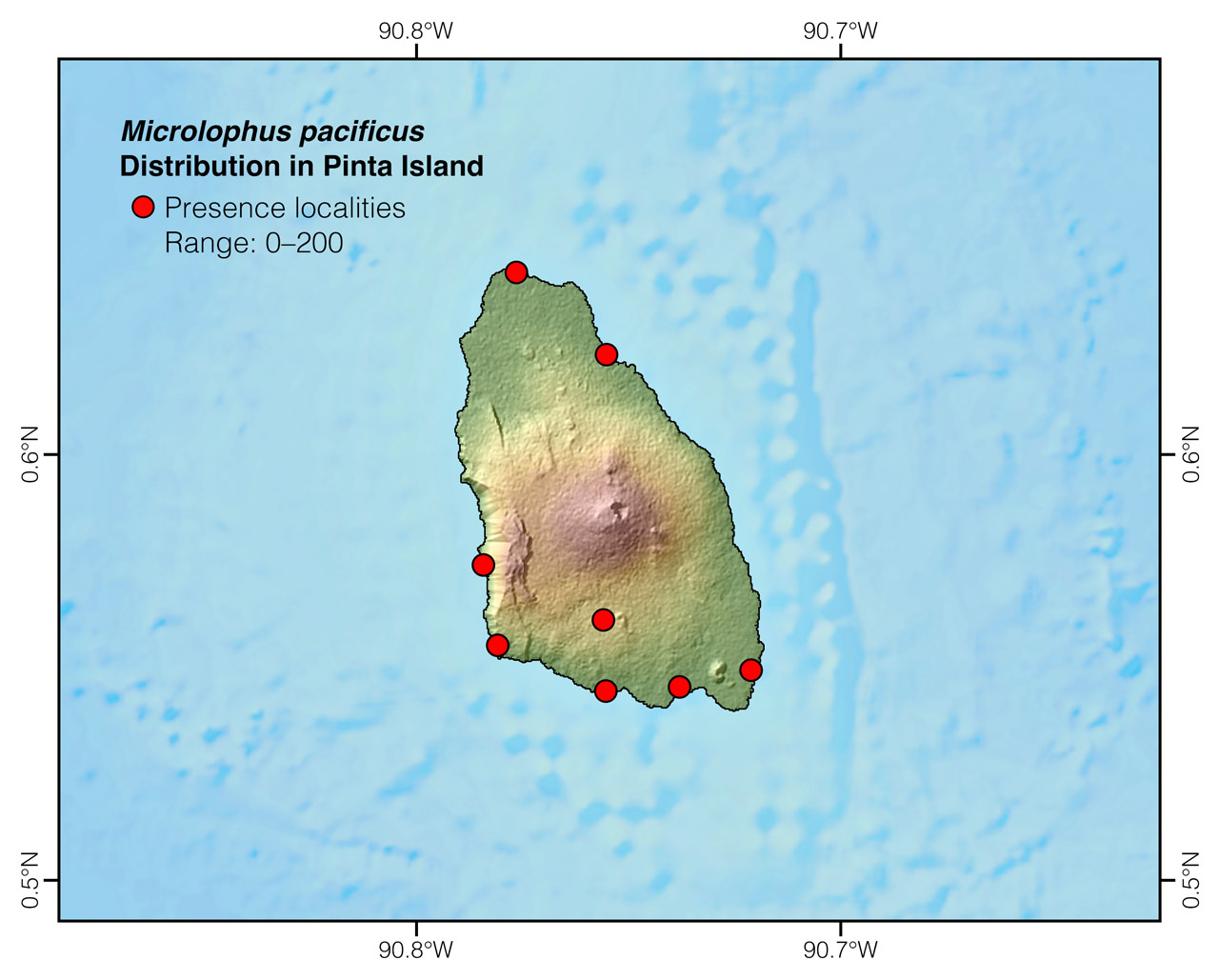Published October 10, 2019. Updated January 26, 2024. Open access. Peer-reviewed. | Purchase book ❯ |
Pinta Lava-Lizard (Microlophus pacificus)
Reptiles of Ecuador | Sauria | Tropiduridae | Microlophus pacificus
English common names: Pinta Lava-Lizard, Common Pacific Iguana.
Spanish common name: Lagartija de lava de Pinta.
Recognition: ♂♂ 25.6 cmMaximum distance from the snout to the tip of the tail. Snout–vent length=8.4 cm. ♀♀ 20.2 cmMaximum distance from the snout to the tip of the tail. Snout–vent length=7.6 cm..1,2 Microlophus pacificus is easily distinguishable from other native lizards occurring on Pinta Island (that is, iguanas and leaf-toed geckos) by having keeled scales on the tail, a skin fold above the shoulder, a raised mid-dorsal crest, and a conspicuously enlarged interparietal scale.1 Microlophus pacificus is the only lava lizard occurring on Pinta Island. Adult males are larger than females and easily recognized by their raised middorsal crest and grayish brown body with scattered black blotches and small white spots.1 Adult females usually have a dark orange head and a cream middorsal stripe (Fig. 1).1

Figure 1: Individuals of Microlophus pacificus from Cabo Ibebetson, Pinta Island, Galápagos, Ecuador. j=juvenile.
Natural history: Microlophus pacificus is a diurnal terrestrial to arboreal lizard that inhabits volcanic rock areas, seasonally dry forests, and dry grasslands of Pinta Island, being absent from the mesic highlands.1 During the early morning and late afternoon, Pinta Lava-Lizards bask and move on soil, rocks, shrubs, and columnar cacti up to 4 m above the ground.1,3 To avoid hot midday hours, they move into the shade, sitting on surfaces that have not been heated by the sun. At night, they remain hidden among rocks, beneath soil, and in leaf-litter. The diet in this species consists of insects (particularly seal flies, grasshoppers, ants, and insect larvae), plants (berries, hard seeds, blossoms, and succulent plant material), and conspecifics.3,4 Both males and females defend territories by performing pushup displays and fighting with intruders.1,5 The clutch size consists of three eggs and the lifespan has been estimated to be around six years.6
Conservation: Least Concern Believed to be safe from extinction given current circumstances..7 Microlophus pacificus is listed in this category because this species is not facing major immediate threats of extinction. Pinta Island is protected within the Galápagos National Park, it is not populated by humans, and is free of introduced species.7 However, since M. pacificus is restricted to a small island, it is prone to be affected by random unpredictable events (like droughts and introduced predators) within a short time period.
Distribution: Microlophus pacificus is endemic to an area of approximately 49 km2 in the lowlands of Pinta Island, Galápagos, Ecuador (Figs 2, 3).

Figure 2: Distribution of Microlophus pacificus in Galápagos. See Appendix 1 for a complete list of the presence localities included in the map.

Figure 3: Distribution of Microlophus pacificus in Pinta Island. See Appendix 1 for a complete list of the presence localities included in the map.
Etymology: The generic name Microlophus comes from the Greek words mikros (=small) and lophos (=crest).1 The specific epithet pacificus refers to the Pacific Ocean.1
See it in the wild: Pinta Island is inaccessible to tourism. Researchers and members of the Galápagos National Park may visit the habitat of Microlophus pacificus, but only in the context of a scientific expedition or a conservation action.
Authors: Alejandro Arteaga,aAffiliation: Fundación Khamai, Reserva Arlequín, Ecoruta Paseo del Quinde km 56, Santa Rosa de Mindo, Pichincha 171202, Ecuador. Gabriela Aguiar,bIndependent researcher, Quito, Ecuador. and Juan M GuayasamincAffiliation: Universidad San Francisco de Quito, Quito, Ecuador.
Academic reviewers: Edgar Benavides,dAffiliation: Yale University, New Have, USA. John Rowe,eAffiliation: Alma College, Alma, USA. and Cruz MárquezfAffiliation: University of Rome Tor Vergata, Rome, Italy.
Photographer: Jose VieiragAffiliation: Tropical Herping (TH), Quito, Ecuador.,hAffiliation: ExSitu, Quito, Ecuador.
How to cite? Arteaga A, Aguiar G, Guayasamin JM (2024) Pinta Lava-Lizard (Microlophus pacificus). In: Arteaga A, Bustamante L, Vieira J (Eds) Reptiles of Ecuador: Life in the middle of the world. Available from: www.reptilesofecuador.com. DOI: 10.47051/BLXN3496
Literature cited:
- Arteaga A, Bustamante L, Vieira J, Tapia W, Guayasamin JM (2019) Reptiles of the Galápagos: life on the Enchanted Islands. Tropical Herping, Quito, 208 pp. DOI: 10.47051/AQJU7348
- Bowman RI (1966) Proceedings of the Symposia of the Galápagos International Scientific Project. University of California Press, Berkeley, 336 pp.
- Schluter D (1984) Body size, prey size and herbivory in the Galápagos lava lizard, Tropidurus. Oikos 43: 291–300. DOI: 10.2307/3544146
- Van Denburgh J, Slevin JR (1913) Expedition of the California Academy of Sciences to the Galápagos Islands, 1905-1906. IX. The Galapagoan lizards of the genus Tropidurus with notes on iguanas of the genera Conolophus and Amblyrhynchus. Proceedings of the California Academy of Sciences 2: 132–202.
- Clark DL, Macedonia JM, Gillingham JC, Rowe JW, Kane HJ, Valle CA (2016) Why does conspecific display recognition differ among species of Galápagos lava lizards? A test using lizard robots. Herpetologica 72: 47–54. DOI: 10.1655/HERPETOLOGICA-D-15-00040
- Carpenter CC (1970) Miscellaneous notes on Galápagos lava lizards (Tropidurus: Iguanidae). Herpetologica 26: 377–386.
- Márquez C, Cisneros-Heredia DF (2016) Microlophus pacificus. The IUCN Red List of threatened species. Available from: www.iucnredlist.org. DOI: 10.2305/IUCN.UK.2016-1.RLTS.T48444939A48444948.en
Appendix 1: Locality data used to create the distribution map of Microlophus pacificus in Ecuador (Fig. 2). Go to the section on symbols and abbreviations for a list of acronyms used.
| Country | Province | Locality | Source |
| Ecuador | Galápagos | Barrancos | Hervías-Parejo 2018 |
| Ecuador | Galápagos | Brown beach | iNaturalist; photo examined |
| Ecuador | Galápagos | Cabo Ibebetson | Arteaga et al. 2019 |
| Ecuador | Galápagos | Playa Posada | Benavides et al. 2009 |
| Ecuador | Galápagos | Playa del Muerto | Hervías-Parejo 2018 |
| Ecuador | Galápagos | Punta norte | Arteaga et al. 2019 |
| Ecuador | Galápagos | Punta sur | Van Denburgh and Slevin 1913 |
| Ecuador | Galápagos | Punta sur, 1 mile inland from | Van Denburgh and Slevin 1913 |